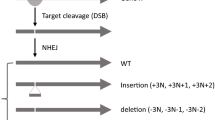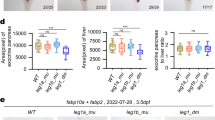Abstract
Functions encoded by single genes in lower organisms are often represented by multiple related genes in the mammalian genome. An example is the retinoblastoma and E2F families of proteins that regulate transcription during the cell cycle. Analysis of gene function using germline mutations is often confounded by overlapping function resulting in compensation. Indeed, in cells deleted of the E2F1 or E2F3 genes, there is an increase in the expression of the other family member. To avoid complications of compensatory effects, we have used small-interfering RNAs that target individual E2F proteins to generate a temporary loss of E2F function. We find that both E2F1 and E2F3 are required for cells to enter the S phase from a quiescent state, whereas only E2F3 is necessary for the S phase in growing cells. We also find that the acute loss of E2F3 activity affects the expression of genes encoding DNA replication and mitotic activities, whereas loss of E2F1 affects a limited number of genes that are distinct from those regulated by E2F3. We conclude that the long-term loss of E2F activity does lead to compensation by other family members and that the analysis of acute loss of function reveals specific and distinct roles for these proteins.
This is a preview of subscription content, access via your institution
Access options
Subscribe to this journal
Receive 50 print issues and online access
$259.00 per year
only $5.18 per issue
Buy this article
- Purchase on Springer Link
- Instant access to full article PDF
Prices may be subject to local taxes which are calculated during checkout




Similar content being viewed by others
References
Attwooll C, Denchi EL, Helin K . (2004). The E2F family: specific functions and overlapping interests. The EMBO J 23: 4709–4716.
Cook JG, Park CH, Burke TW, Leone G, DeGregori J, Engel A et al. (2002). Analysis of Cdc6 function in the assembly of mammalian prereplication complexes. Proc Natl Acad Sci USA 99: 1347–1352.
Cress WD, Johnson DG, Nevins JR . (1993). A genetic analysis of the E2F1 gene distinguishes regulation by Rb, p107, and adenovirus E4. Mol Cell Biol 13: 6314–6325.
Dimova DK, Dyson NJ . (2005). The E2F transcriptional network: old acquaintances with new faces. Oncogene 24: 2810–2826.
Dyson N . (1998). The regulation of E2F by pRB-family proteins. Genes Dev 12: 2245–2262.
Gentleman RC, Carey VJ, Bates DM, Bolstad BM, Dettling M, Dudoit S et al. (2004). Bioconductor: open software development for computational biology and bioinformatics. Genome Biol 5: R80.
Giangrande PH, Hallstrom TC, Tunyaplin C, Calame K, Nevins JR . (2003). Identification of the E box factor TFE3 as a functional partner for the E2F3 transcription factor. Mol Cell Biol 23: 3707–3720.
He T-C, Zhou S, da Costa LT, Yu J, Kinzler KW, Vogelstein B . (1998). A simplified system for generating recombinant adenoviruses. Biochem Biophys Res Comm 95: 2509–2514.
Humbert PO, Verona R, Trimarchi JM, Rogers C, Dandapani S, Lees JA . (2000). E2f3 is critical for normal cellular proliferation. Genes Dev 14: 690–703.
Irizarry RA, Bolstad BM, Collin F, Cope LM, Hobbs B, Speed TP . (2003). Summaries of Affymetrix GeneChip probe level data. Nucleic Acids Res 31: e15.
Ishida S, Huang E, Zuzan H, Spang R, Leone G, West M et al. (2001). Role for E2F in the control of both DNA replication and mitotic functions as revealed from DNA microarray analysis. Mol Cell Biol 21: 4684–4699.
Johnson DG, Schwarz JK, Cress WD, Nevins JR . (1993). Expression of transcription factor E2F1 induces quiescent cells to enter S phase. Nature 365: 349–352.
Leone G, DeGregori J, Yan Z, Jakoi L, Ishida S, Williams RS et al. (1998). E2F3 activity is regulated during the cell cycle and is required for the induction of S phase. Genes Dev 12: 2120–2130.
Moroni MC, Hickman ES, Denchi EL, Caprara G, Colli E, Cecconi F et al. (2001). Apaf-1 is a transcriptional target for E2F and p53. Nat Cell Biol 3: 552–558.
Muller H, Bracken AP, Vernell R, Moroni MC, Christians F, Grassilli E et al. (2001). E2Fs regulate the expression of genes involved in differentiation, development, proliferation, and apoptosis. Genes Dev 15: 267–285.
Nevins JR . (1998). Toward an understanding of the functional complexity of the E2F and Retinoblastoma families. Cell Growth Differ 9: 585–593.
Nevins JR . (2001). The Rb/E2F pathway and cancer. Hum Mol Genet 10: 699–703.
Nevins JR, DeGregori J, Jakoi L, Leone G . (1997). Functional analysis of E2F. Meth Enzymol 283: 205–219.
Polager S, Kalma Y, Berkovich E, Ginsberg D . (2002). E2Fs up-regulate expression of genes involved in DNA replication, DNA repair and mitosis. Oncogene 21: 437–446.
Qin X-Q, Livingston DM, Kaelin WG, Adams PD . (1994). Deregulated transcription factor E2F-1 expression leads to S-phase entry and p53-mediated apoptosis. Proc Natl Acad Sci USA 91: 10918–10922.
Rempel RE, Saenz-Robles MT, Storms R, Morham S, Ishida S, Engel A et al. (2000). Loss of E2F4 activity leads to abnormal development of multiple cellular lineages. Mol Cell 6: 293–306.
Sage J, Miller AL, Perez-Mancera PA, Wysocki JM, Jacks T . (2003). Acute mutation of retinoblastoma gene function is sufficient for cell cycle re-entry. Nature 424: 223–228.
Schlisio S, Halperin T, Vidal M, Nevins JR . (2002). Interaction of YY1 with E2Fs, mediated by RYBP, provides a mechanism for specificity of E2F function. EMBO J 21: 5775–5786.
Sherr CJ . (1996). Cancer cell cycles. Science 274: 1672–1677.
Smith DS, Leone G, DeGregori J, Ahmed MN, Qumsiyeh MB, Nevins JR . (2000). Induction of DNA replication in adult rat neurons by deregulation of the retinoblastoma/E2F G1 cell cycle pathway. 11: 625–633.
Wu L, Timmers C, Maiti B, Saavedra HI, Sang L, Chong GT et al. (2001). The E2F1–3 transcription factors are essential for cellular proliferation. Nature 414: 457–462.
Yu JY, DeRuiter SL, Turner DL . (2002). RNA interference by expression of short-interfering RNAs and hairpin RNAs in mammalian cells. Proc Natl Acad Sci USA 99: 6047–6052.
Zhu W, Giangrande P, Nevins JR . (2004). E2Fs link the control of G1/S and G2/M. EMBO J 23: 4615–4626.
Acknowledgements
We thank Drs David Turner and Yang Shi for providing U6 promoter and technical advices. We thank Dr Rachel Rempel for providing MEFs. This work was supported by grants from the NIH (CA104663, CA106520, CA112952). Finally, we thank Kaye Culler for her assistance in the preparation of the manuscript.
Author information
Authors and Affiliations
Corresponding author
Additional information
Supplementary Information accompanies the paper on the Oncogene website (http://www.nature.com/onc).
Rights and permissions
About this article
Cite this article
Kong, LJ., Chang, J., Bild, A. et al. Compensation and specificity of function within the E2F family. Oncogene 26, 321–327 (2007). https://doi.org/10.1038/sj.onc.1209817
Received:
Revised:
Accepted:
Published:
Issue Date:
DOI: https://doi.org/10.1038/sj.onc.1209817
Keywords
This article is cited by
-
Genomic profiling of the transcription factor Zfp148 and its impact on the p53 pathway
Scientific Reports (2020)
-
Consensus transcriptional regulatory networks of coronavirus-infected human cells
Scientific Data (2020)
-
Setd2 deficiency impairs hematopoietic stem cell self-renewal and causes malignant transformation
Cell Research (2018)
-
Inhibitors of histone acetyltransferases KAT6A/B induce senescence and arrest tumour growth
Nature (2018)
-
MicroRNA-210 induces apoptosis in colorectal cancer via induction of reactive oxygen
Cancer Cell International (2016)



